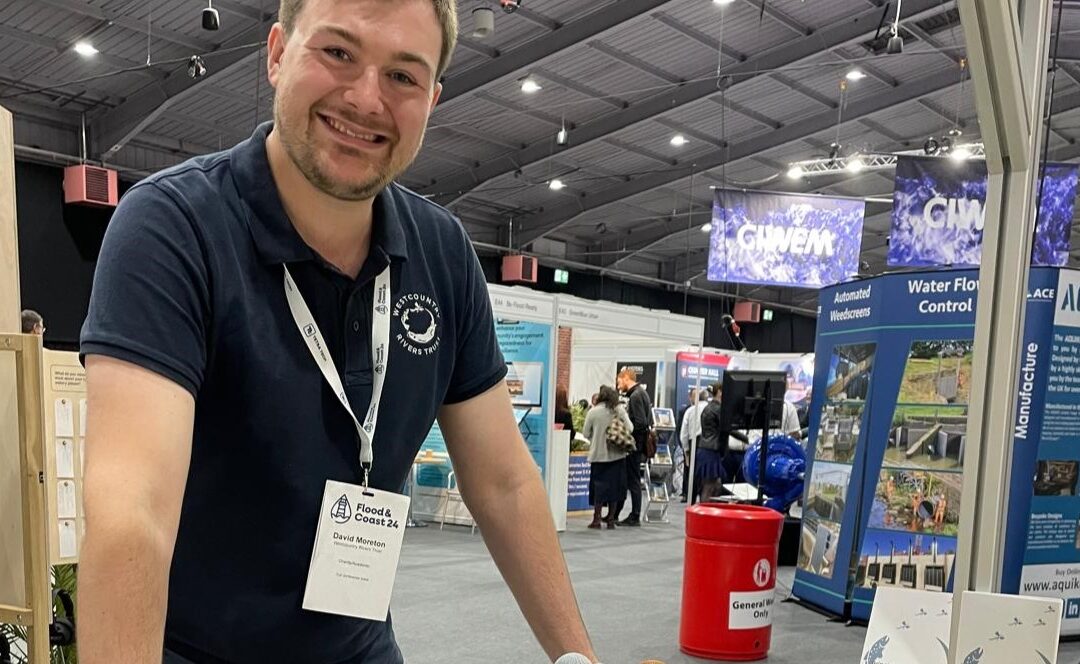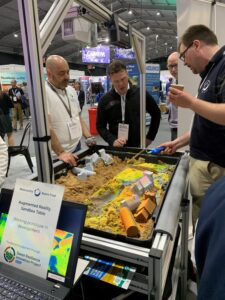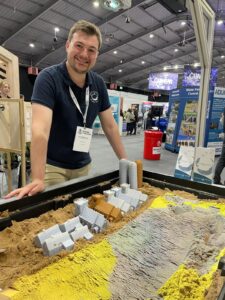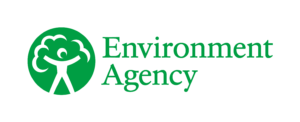It hasn’t just been with board members from the Devon Resilience Innovation Project (DRIP) – click to read this post – that our Augmented Reality (AR) sand table had its moment in the sun.
CIWEM Flood & Coast 2024 Conference
In the run up to the General Election, we attended the CIWEM Flood & Coast 2024 Conference.
Over three days, the conference hosted 2,400 attendees, with at least 400+ drawn to AR sand table, which was displayed on the Flood & Coastal Innovation Programme (FCIP) stall .
New & Improved
Supported by Devon County Council (DCC), our visit highlighted the new and improved table set up. This includes several new features such as an integrated sandbox within the frame, superior dynamic software for augmented water flow and various 3D printed accessories to increase relatability.
The AR sand table has been recognised for its potential to demonstrate various customisable topographic and hydrographic scenarios, ranging from:
- Natural Flood Management (NFM) strategies
- Catchment management techniques using Nature-based Solutions (NbS)
- Primary and secondary school education sessions in geography, science and technology.
The sand can be modelled to provide visual representation of a catchment, and how water flows across the land. It is an interactive tool, where people can move the sand, add in buildings or flood interventions and simulate rainfall to demonstrate the effectiveness of different flood management techniques.
David Moreton, River Woodland Officer at WRT said:
“Throughout the conference, hundreds of attendees engaged with the table and our staff, asking questions about the trust, how the table worked and what its functions are.
“People’s curiosity drew them to the table, before they engaged in a mix of playfulness and thought provocation.”
Depending on the audience and questions asked, various sandbox demonstrations could be tailored to accommodate individual/ group needs.
Example scenarios
Some of the scenarios our team highlighted on the AR sand table included:
- Rapid Response Catchment – situated within Dartmoor National Park, scenarios were recreated with emphasis on community engagement and collaboration to ascertain the best NbS to manage surface water flooding experienced by the communities. The team demonstrated the various NFM options for consideration: hedgerows/trees through increase sand roughness and slightly better infiltration setting, scrapes and bunds, and ultimately soil aeration which had the best appeal and potential impact without changing the Dartmoor landscape.
- The water cycle, erosion and deposition – a child estimated to be eight-years-old engaged with the ARS table and the team was able to go through primary school curricula, exploring the water cycle (precipitation of AR water), transportation/run-off, infiltration, storage, evaporation (imitated by increasing infiltration setting) and precipitation (hand movements). Erosion and deposition processes were also showcased to encourage learning of physical geography. Lastly, for fun, a volcano with a caldera was built, with lava spilling out over a town, with the child tasked on redirecting the ‘lava’ (recolored water) to save the town.
- Fish passage, weir removal and leat impact – some attendees asked to the team to demonstrate the impact of a weir removal with a leat upstream. This was simulated by a physical sand obstruction in the AR river with a small channel representing the leat. Upon removing the weir, the impounded water behind the weir flowed down, draining the leat, demonstrating the wider issues organisations may face when altering such features. A V-notch in the weir and an additional fish passage (a channel around the weir) was then implemented, showing a passage could be achieved without draining the leat, and reducing the allopatric impact of the weir.
Although kept very busy during the event, we received multiple feedback comments from individuals and other flood-related organisations attending, with some shared below.
“Astounding! Has enormous potential in all sorts of ways.”
“It was very nice and shows an outstanding solution to encourage people to participate in the flood process.”
And, for David personally, his passion for our AR sand table did not go unnoticed by colleagues.
“I want to take a moment to express my appreciation for your passion and dedication to the Augmented Reality Sandbox table experience. Your enthusiasm for this technology is truly infectious and has played a significant role in engaging the public and promoting learning. In addition, your positive attitude and approach to challenges have not gone unnoticed. Your ability to tackle obstacles with a smile and a can-do attitude has had a positive impact on everyone around you. Thank you for all that you do and for being such an inspiring member of our team.”
Suggestions to help us keep evolving the table included making our software development open access; providing a crib sheet for use when not manned; and different impermeability settings. We will be taking all feedback on board.
One of the most valuable findings has been hearing that the table and method of demonstration allows for an inclusive approach to engagement, ensuring people who benefit from visual and kinesthetic aids can access and understand the processes and situations described.
This highlights the versatility of the table for various audiences of all ages, knowledge and work backgrounds.
Our RRC project is a part of DRIP, which in turn is a part of the FCRIP programme under the FCIP.
(updated 1 August 2024).





